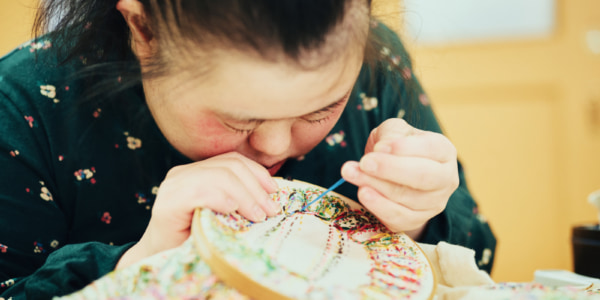Prologue: What emerges from relationships
‘Kizashi and Manazashi’ is an open call exhibition that has been held in Yamagata since 2019. It focuses on the “expressions” (kizashi) of people with disabilities and the “gaze” (manazashi) that follows them. TAKEDA Kazue is one of the people working behind the scenes on the exhibition. She visits welfare facilities and individuals all over Japan to ask about expressive activities that are currently taking place.
What is ‘Kizashi and Manazashi’? Takeda shares an example. At one welfare facility, there was a person who would take equipment outside and line it up in the parking lot on a near-daily basis. Of course, from the perspective of those who wanted to use the equipment, this behavior was nothing but trouble. The staff, however, while perplexed by this person’s behavior, continued to take photographs and document it from their own honest point of view: “Why are they doing this?” They saw in this person’s collection of “mischievous” activities an expression of the person’s will.
“Actions seen as problematic behavior could, when viewed differently, be artistic activity that creates things. This is why the ‘Kizashi and Manazashi’ exhibition introduces the ‘expressions’ (kizashi) that emerge from such relationships,” says Takeda.
![[Photograph]柿が実る木の枝を下からとらえた写真。背景には薄青い空が広がり、柿の実は陽光に照らされている。](https://staging2022.diversity-in-the-arts.jp/admin/wp-content/uploads/2023/12/img_araki-01.jpg)
Living in a peaceful world filled with love and happiness
Sagae City is located 30 minutes north of Yamagata City by car. The first place we visited was Sakuranbo Kyouseien, a facility run by the social welfare corporation Sakuranbo Kyouseikai.
We arrived at around 10:00 in the morning. The atelier had an easy-going vibe, and there were all kinds of people doing their own things: people holding colorful pens and drawing pictures in silence, people packing dried dokudami (Houttuynia cordata) leaves into packs, and people walking around while talking with others.
“Isn’t this relaxed atmosphere great? They try to respect what each person wants to do here. It’s a facility that values accepting each other’s freedom of being,” Takeda whispers to us. We spotted ARAKI Keiji, dressed in a conspicuously colorful outfit, among the people there.
![[Photograph]さくらんぼ共生園の自分の作業机で、絵の創作にいそしむ荒木さんの後ろ姿。](https://staging2022.diversity-in-the-arts.jp/admin/wp-content/uploads/2023/12/img_araki-02.jpg)
“Keiji is very stylish. Even his personal items are cute. When he sits down to eat, he sometimes decorates the table with flowers,” says staff member KONDO Yuzuko. After a quick greeting, Keiji took his bag—which he had decorated himself—and his favorite pouches off the shelves and showed them to us one by one. They were all covered in hearts, character designs, and were in shades of pink.
We also got a glimpse into his regular drawing process. Keiji wove soft dotted lines and bold strokes together to create the outlines of his image. Eventually, a scene began to emerge: a woman and a man side by side. When we asked him what he was drawing, Keiji replied, “My fiancée.” Upon further questioning, he told us that he had met his sweetheart when he was 18 years old, and that although they now live far apart from each other, they plan to be together at some point in the future.
“I wonder if his fiancée is one of the driving forces behind Keiji’s desire to create things. I’ve been rejected by him six times, saying, ‘I can’t marry you,’” Kondo says with a smile.
Keiji started showing up regularly at Sakuranbo Kyouseien about 10 years ago. Until then, he had worked in an office with many men involved in woodworking. His clothes at that time were simple: a shirt and pants. Once he started drawing, however, he began to use hearts more often. Then, inspired by another member’s love of fashion, Keiji’s own unique fashion sense gradually came to life and blossomed.
![[Photograph]荒木さんが、ピンク色の服を着た黒髪の女性を描く様子を、背後から写した様子。](https://staging2022.diversity-in-the-arts.jp/admin/wp-content/uploads/2023/12/img_araki-05.jpg)
“Keiji may be embodying a peaceful worldview filled with love and happiness through the pictures he draws and the clothing he wears,” says Takeda. Keiji cherishes this feeling of longing, and Kondo believes in and supports Keiji “just the way he is.”
![[Photograph]〈さくらんぼ共生園〉スタッフの近藤柚子さんと、荒木さんが笑顔で話している様子。近藤さんの手元には、荒木さんの描いた女性の絵がある。](https://staging2022.diversity-in-the-arts.jp/admin/wp-content/uploads/2023/12/img_araki-06.jpg)


![[Photograph]](https://staging2022.diversity-in-the-arts.jp/admin/wp-content/uploads/2023/12/img_araki-main.jpg)







